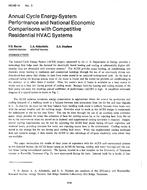Double-skin façades have been increasingly used, as they open up new possibilities for clients and planners seeking creative new designs that are intelligently adapted to environmental conditions. Natural ventilation is commonly carried out in a building with double-skin façades; however, doubleskin façade construction is still not covered by statutory building regulations. Virtually no information exists on the behavior of this kind of façade in case of a fire. Usually, for a building with a multistory double-skin façade, smoke from a fire room escaping through the inner façade into the intermediate space between the two skins may accumulate and spread horizontally and/or vertically to other rooms that have openings connected to the intermediate space for the purpose of natural ventilation. However, considering the similarity of smoke movement and stack ventilation—both driven by stack effect—this paper considers using a double-skin façade for smoke control as well as for natural ventilation. As a result, it is proved that smoke spread can be prevented with suitable arrangement of openings. Therefore, natural ventilation and smoke control can be realized through one system. Reduced-scale model experiments and computational fluid dynamics (CFD) analysis were carried out in this research.
Units: SI
Citation: ASHRAE Transactions, vol. 112, pt. 1
Product Details
- Published:
- 2006
- Number of Pages:
- 8
- File Size:
- 1 file , 13 MB
- Product Code(s):
- D-28018


